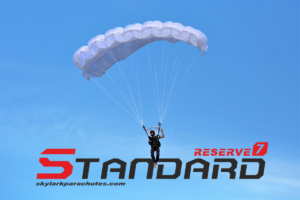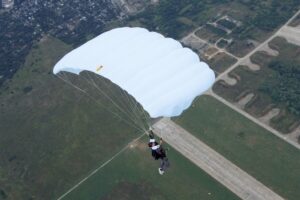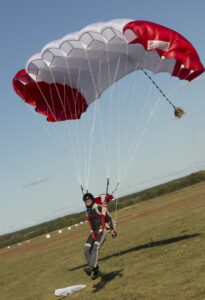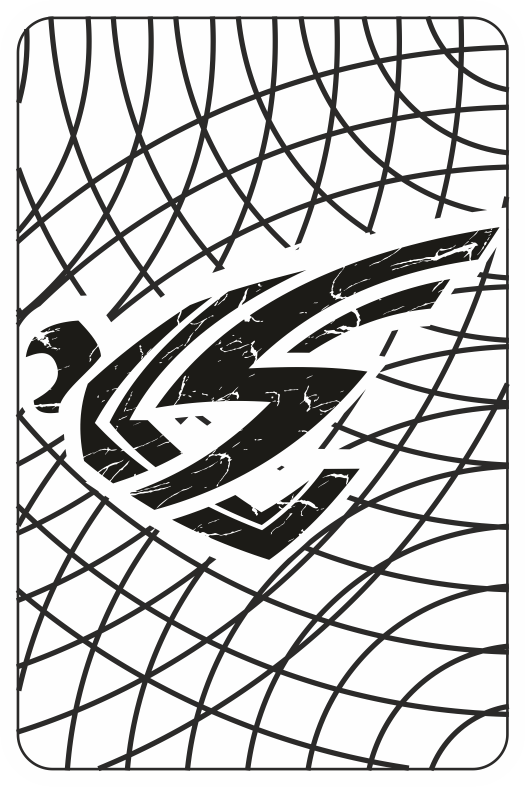Standard-7 cell
Let’s talk about one of the most important parts of your equipment. Try skydiving without it and, let’s just say, it’ll be a challenging situation!

So, the reserve. Is there anyone who doubts the importance of this part of the skydiving equipment? It’s not a coincidence at all that the reserve canopy is located neatly packed in the upper portion of the skydiver`s gear, has an optimal design, and meets the requirements all pilots need!
A special place among the variety of Skylark’s parachute designs takes the STANDARD-7. It’s a 7-cell rectangular ram-air pressurized gliding canopy. It has an optimal aspect ratio (span to chord ratio) and a modified wing profile shape. Due to these design features, STANDARD-7 achieves a good glide & flare performance intended for providing a stable descent and a soft landing in case of a main parachute malfunction.
 The STANDARD-7 has a thoroughly thought-out design and proven reliability. The canopy has been tested according to TSO-C23d requirements with a performance margin under various conditions. For all possible scenarios, in which a skydiver would use the reserve, numerous tests have been performed. For either manual or automatic activation, either immediately or after any delay, at altitudes up to 4500 m above sea level and after separation from the aircraft at indicated airspeed from 0 to 292 km/h. [Tests were also conducted for mass and speed values exceeding the specified values by 20%]. The max force you experience momentarily upon the reserve opening is 8.6 G.
The STANDARD-7 has a thoroughly thought-out design and proven reliability. The canopy has been tested according to TSO-C23d requirements with a performance margin under various conditions. For all possible scenarios, in which a skydiver would use the reserve, numerous tests have been performed. For either manual or automatic activation, either immediately or after any delay, at altitudes up to 4500 m above sea level and after separation from the aircraft at indicated airspeed from 0 to 292 km/h. [Tests were also conducted for mass and speed values exceeding the specified values by 20%]. The max force you experience momentarily upon the reserve opening is 8.6 G.
Make your canopy selection based on canopy performance characteristics according to parachutist skills and activity.
STANDARD-7 performance data
|
Size, sq.ft |
108 |
119 |
130 |
146 |
162 |
175 |
189 |
216 |
235 |
255 |
272 |
290 |
|
Packing volume, cu in*** |
261 |
283 |
305 |
338 |
371 |
400 |
426 |
482 |
524 |
564 |
598 |
638 |
|
Weight, lb (kg) |
3.4 (1.6) |
3.9 (1.8) |
4.4 (2.0) |
5.0 (2.3) |
5.6 (2.5) |
6.0 (2.7) |
6.4 (2.9) |
7.2 (3.3) |
7.8 (3.5) |
8.0 (3.6) |
8.4 (3.8) |
8.5 (3.9) |
|
Aspect ratio |
2.05 |
2.04 |
2.03 |
2.01 |
1.99 |
1.97 |
1.96 |
1.93 |
1.91 |
1.89 |
1.89 |
1.88 |
|
Max. wing loading, lb/sq.ft |
2.0 |
2.0 |
2.0 |
1.8 |
1.72 |
1.59 |
1.47 |
1.29 |
1.18 |
1.09 |
1.02 |
0.96 |
|
Min. wing loading, lb/sq.ft |
0.6 |
0.6 |
0.6 |
0.6 |
0.6 |
0.6 |
0.6 |
0.6 |
0.6 |
0.6 |
0.6 |
0.6 |
|
Recommended wing loading, lb/sq.ft |
1.3 |
1.3 |
1.3 |
1.2 |
1.16 |
1.09 |
1.04 |
0.95 |
0.89 |
0.85 |
0.81 |
0.78 |
|
Forward speed *, m/s |
12.2 |
12.2 |
12.1 |
11.9 |
11.8 |
11.7 |
11.5 |
11.1 |
10.9 |
10.7 |
10.4 |
10.3 |
|
Vertical speed*, m/s |
5.4 |
5.4 |
5.4 |
5.2 |
5.1 |
5.0 |
4.8 |
4.5 |
4.4 |
4.3 |
4.2 |
4.0 |
|
Max. all-up weight**, lb (kg) |
262 (119) |
279 (127) |
||||||||||
|
Max. deployment speed allowed**, kn (km/h) |
||||||||||||
* At the recommended wing loading and without pulling the steering lines
** The tests were conducted at a maximum all-up weight of 360 pounds (163 kg), a deployment speed of 189 knots (350 km/h) at 15℃ and an altitude of 150 m above sea level.
*** Сould vary +/‐ 10% or more depending on climate conditions, storage, use degradation, packing techniques and environment.
 The entire canopy of the STANDARD-7 is made of low-porosity F-111 nylon fabric (PIA-C 44378. Type IV) and reinforced with standardized tapes (MIL- standards) that are widely used in the parachute industry. Optionally, the parachute can be made of PN-9 fabric if a smaller pack volume is required (saving approximately 11-13%).
The entire canopy of the STANDARD-7 is made of low-porosity F-111 nylon fabric (PIA-C 44378. Type IV) and reinforced with standardized tapes (MIL- standards) that are widely used in the parachute industry. Optionally, the parachute can be made of PN-9 fabric if a smaller pack volume is required (saving approximately 11-13%).
Main suspension lines are made of Spectra / Microline 725 lb, lower steering lines are made of Spectra / Microline 1050 lb. A slider has a hole in it to make the parachute opening more stable and to decrease the opening shock. Maintenance requirements for the reserve parachute STANDARD-7
You don’t have to perform any specific operations when taking care of your parachute, but it is mandatory to complete the required maintenance of a reserve canopy in order for skydiving gear to retain the characteristics and the declared service life. When not in use, you must stow away your reserve parachute in a parachute pack in a dry, cool, clean and UV ray’s free environment. An ambient temperature must be from -30℃ to +30℃ and a relative humidity not greater than 80%.
STANDARD-7 was designed to last a maximum of ten times if properly maintained as per the manufacturer’s recommendations. Designated use period – according to the technical condition within the designated service life. Storage time up to 20 years.
Fly safe!

